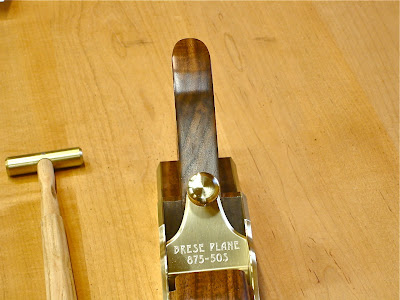
Usually when people order an infill plane they're sort in for a penny in for a pound, if you know what I mean. Most woodworkers, and thank heavens there are exceptions, will typically order one infill and it will typically be a final finishing plane which explains the popularity of smoothing planes as compared to other type hand planes.
I offer walnut as a standard infill wood but I seldom build a plane with that infill wood. I stock walnut that I purchase from a supplier in Idaho. This material is harvested specifically for gun stocks and is air dried in the high desert environment. For this reason it is typically more interesting looking than your average walnut and the color is typically quite good as well.
But I digress, most customers decide that it's worth it to spring for the more exotic and dense woods for this type purchase so I seldom make a plane with walnut infill.

When I first selected the walnut for this plane I wasn't particularly impressed. I chose it because it appeared evenly grained and this plane is going to a shop in Chicago and shops that are close to major lakes typically need this consideration. However once I started the polishing process on these bits it did what wood commonly does....it surprises you.
I was applying a polish of garnet shellac and as this process progressed the contrasting colors of this walnut became quite apparent. Actually this piece was rather unusual with lighter golden colors contrasting with the darker brown areas of this wood. I had certainly underestimated the character if this piece.

This plane is a bit different in other ways as compared to the 875 Model planes that I've made in the past. Those planes had the model numbers 875-250 and 875-W50. The 875-250 plane used a 2" wide iron and was pitched at 50 degrees and the 875-W50 was the same configuration but accommodated a wider 2.25" wide iron.
I always preferred the plane with the 2" iron. Yes, I'm one of those people that like a narrower smoothing plane, plus I like to maintain a mass to iron width ratio that makes a plane easy to push thru the cut. Planing should be a pleasurable experience especially in the final smoothing stage of your work. A time to relax a bit after the hard work of using planes we rely on for the heavier wood removal required for straightening and flattening.
My recent design emphasis has been to find the ideal ratio between mass and iron width and to refine the balance of the elements that make up the 875 plane. The plane pictured above is the result of this work. The older version 875-250 typically weighed right around 6 pounds with a dense exotic infill and just a few ounces lighter with walnut infill. This new version which is now Model 875-50S uses a 2.125" wide iron and weighs 5 pounds 5 ounces with walnut infill and will probably have a weight of 5 pounds 8 or 9 ounces with dense exotic infill.
In the new configuration this plane now has a wider iron than the 2" wide version and weighs 1/2 pound less. A half pound is quite a profound weight reduction for plane of this size.
So how did I increase the width and take 8 ounces of weight out of this plane. The largest surfaces on this plane are the sole and the iron and those are the best area to look for weight reduction. The sole went from .375 thick to .312 thick and the iron went from .250 thick to .218 thick. The result is a plane that is easy to push thru the cut but doesn't tug on your wrist in the return stroke. It was this slight tug on your wrist that I was looking to eliminate.
I've been using this plane for the last couple of days since it's completion and I have to say I think it is a very refined version of this plane.
Ron
 Usually when people order an infill plane they're sort in for a penny in for a pound, if you know what I mean. Most woodworkers, and thank heavens there are exceptions, will typically order one infill and it will typically be a final finishing plane which explains the popularity of smoothing planes as compared to other type hand planes.
Usually when people order an infill plane they're sort in for a penny in for a pound, if you know what I mean. Most woodworkers, and thank heavens there are exceptions, will typically order one infill and it will typically be a final finishing plane which explains the popularity of smoothing planes as compared to other type hand planes.



















































